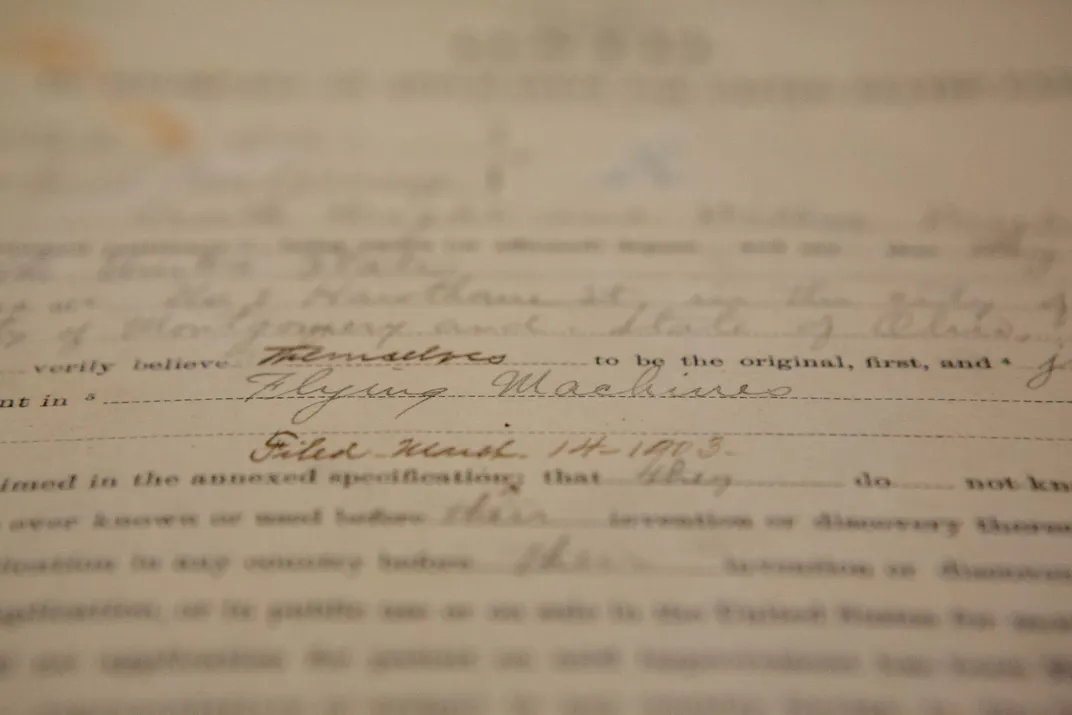Wright Brothers’ Long-Lost Patent Gets a Private Family Viewing
At the National Archives, a close look at aviation’s birth certificate.
/https://tf-cmsv2-smithsonianmag-media.s3.amazonaws.com/filer/67/5c/675cbdf8-ab9b-4c5a-8999-907922ab11da/wright_patents_july_16.jpg)
On July 2, a pair of visitors to the National Archives in Washington, D.C. came face-to-face with a vital part of their family’s history for the first time—documents that also mark the beginning of the age of flight. The Wright brothers’ great-grandniece Janette Davis and her son Keith Yoerg were ushered into a room used for preparing exhibits, where they were greeted by Debra Wall, the Deputy Archivist of the United States, and Senior Registrar Jim Zeender. On a long table were three folders containing the once lost, recently rediscovered patent application of the Wright brothers—the airplane’s birth certificate.
Davis and Yoerg both have a scholarly interest in their famous relatives. Davis studied the Wright patent suits on the way to getting a graduate degree in Public Affairs. Yoerg recently graduated from the University of Southern California with a degree in astronautical engineering. For both, the Wrights have been lifelong inspirations, and as Zeender took them through each folder, they eagerly leaned in to get a closer look at the Mylar-covered pages. A familiar name quickly jumped off the pages: Harry Toulmin, the Wrights’ attorney who urged them to file the application and guided them through the legalities. In the folder was a receipt for his services—for $20.
The application process began in March 1903, by which time the Wrights had not yet finished building their famous Flyer. In fact, the application is not for their powered airplane at all, but for “Improvements in Flying Machines.” Specifically, the Wrights wanted to patent what they had developed over hundreds of flights in their 1902 glider—three-axis control. (The brothers later got into disputes, most famously with Glenn Curtiss, over whether they had patented the concept of three-axis control or just their mechanism of achieving roll control. The Wrights eventually won.)

Looking over the application files 113 years later, Davis and Yoerg could clearly see that the Wrights had to do a lot of explaining to the patent examiners. At the time, flying machine applications were rare, but not unheard of. And it was obvious that the examiner hadn’t initially understood the Wrights’ invention. The brothers answered detailed questions over many pages, to the point of defining terms like warp and twist. They even sent the examiners a small cardboard box with a letter instructing them where to place their fingers and thumbs to achieve a helical twist—a visual aide that had inspired Wilbur one day while playing with an inner tube box in the brothers’ bike shop.
The visit to the Archives had deep meaning for Davis and Yoerg. “We grew up knowing Orville and Wilbur as family, first and foremost,” says Davis. “That letter captures their personality, and in it, I hear our uncles and it makes me smile.” Yoerg is working toward a career in spaceflight, which he sees entering an era of great innovation. He appreciates why his famous ancestors went to the trouble to get a patent. “They realized how essential it was in order to protect their invention,” he says, “And obtaining it before they had flown [the powered airplane] shows how holistically they approached the problem.”
When the last folder was opened, there were quiet gasps. Anyone who has studied the Wright brothers in detail has seen the famous patent drawing based on the 1902 glider. Davis and Yoerg found themselves staring at an original. They took a very long look.